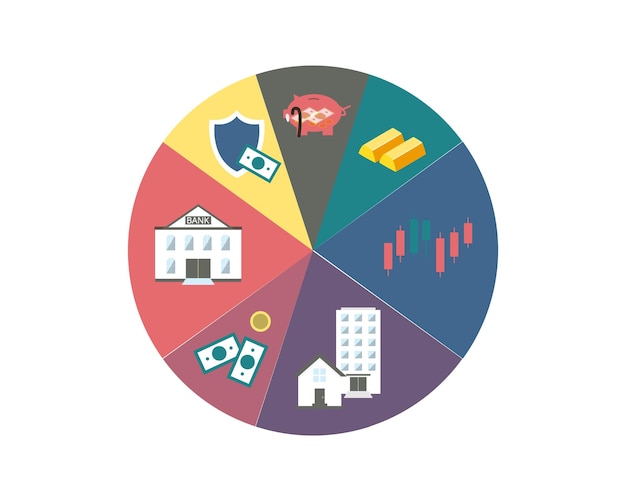Investing for Beginners: Risk Tolerance & Investment Choices

Beginning investors need to understand their risk tolerance to make suitable investment choices, as it greatly influences the types of assets they should consider for their portfolio.
Embarking on the journey of investing can feel like navigating uncharted waters. One of the most crucial steps for any beginner is understanding their risk tolerance and how it should influence the selection of suitable investments. Let’s dive into **investing for beginners: understanding risk tolerance and choosing the right investments** to help you build a solid foundation for your financial future.
Understanding Risk Tolerance in Investing
Before you start picking stocks or bonds, it’s essential to understand your own comfort level with risk. Risk tolerance is your capacity to stomach potential losses in exchange for potentially higher returns. It’s a personal assessment that influences your investment decisions significantly.
Several factors shape your risk tolerance. Let’s explore a few.
Factors Influencing Risk Tolerance
Risk tolerance isn’t static, and understanding the factors that influence it can help you better gauge your comfort with various investment options.
- Age and Time Horizon: Younger investors typically have a longer time horizon, allowing them to take on more risk as they have time to recover from potential losses.
- Financial Goals: What are you investing for? Retirement, a down payment on a house, or a child’s education? Your goals will dictate how much risk you can reasonably afford to take.
- Financial Situation: Your income, savings, and existing investments all play a role. If you have ample savings and a steady income, you might be comfortable with higher-risk investments.
- Knowledge and Experience: The more you understand about investing, the more comfortable you may become with taking calculated risks.
Understanding these factors will help you categorize yourself into a risk profile.
Basic Risk Profiles
Investors generally fall into one of three broad risk profiles:
- Conservative: Prefer low-risk investments that prioritize capital preservation, such as government bonds or certificates of deposit (CDs).
- Moderate: Comfortable with a mix of low- and medium-risk investments, such as a balanced portfolio of stocks and bonds.
- Aggressive: Willing to take on higher risk for the potential of higher returns, often investing in growth stocks or emerging markets.
In summary, understanding your risk tolerance helps you make informed investment choices that are aligned with your comfort level and financial goals. Knowing where you stand will prevent you from making emotionally driven decisions during market volatility.

Assessing Your Personal Risk Tolerance
Now that you understand what factors influence risk tolerance, how do you determine yours? There are several methods you can use to evaluate your personal risk appetite.
Let’s delve into a few practical approaches.
Risk Tolerance Questionnaires
Many brokerage firms and financial websites offer risk tolerance questionnaires. These questionnaires ask a series of questions about your investment goals, time horizon, and comfort level with potential losses. The results provide a general indication of your risk profile.
Consider the following sample questions:
- What is your primary investment goal?
- How long do you plan to invest before needing the money?
- How would you react to a 20% loss in your investments?
- Which statement best describes your investment philosophy?
Self-Reflection and Financial Planning
Think about your past experiences with risk. Have you ever made a risky investment that paid off? Or have you been burned by a bad bet? Consider how you reacted emotionally to those experiences. Also, consider your broader financial plan. Are you saving for retirement, a down payment on a home, or something else? The purpose of your investments will influence how much risk you can afford to take.
When you consider your financial plan, consider the following questions:
- What are your long-term financial goals?
- How close are you to achieving those goals?
- What other assets do you have?
- What is your ability to save regularly?
A combination of questionnaires and self-reflection can provide a well-rounded understanding of your risk tolerance. The key is to be honest with yourself about your comfort level with risk.
Matching Investments to Your Risk Profile
Once you’ve determined your risk tolerance, the next step is to choose investments that align with your profile. Different asset classes carry different levels of risk, and it’s essential to understand these differences before investing your money.
Different assets have varying volatility.
Understanding Different Asset Classes
Asset classes are broad categories of investments, such as stocks, bonds, and real estate. Each asset class has its own risk and return characteristics.
Here are some common asset classes to consider:
- Stocks: Represent ownership in a company and offer the potential for high returns, but also carry a higher risk of loss.
- Bonds: Represent debt and offer a more stable source of income with lower risk compared to stocks.
- Real Estate: Can provide income through rent and potential appreciation, but it’s less liquid than stocks and bonds.
Building a Diversified Portfolio
Diversification is the practice of spreading your investments across different asset classes to reduce risk. A well-diversified portfolio can help you achieve your financial goals while minimizing potential losses. For example, a conservative investor might allocate a larger portion of their portfolio to bonds, while an aggressive investor might allocate more to stocks.
Here are the steps to consider for diversification:
- Determine your asset allocation based on your risk tolerance.
- Choose investments within each asset class.
- Rebalance your portfolio periodically to maintain your desired asset allocation.
Matching your investments to your risk profile is crucial for long-term investment success. It helps you stay calm during market fluctuations and stick to your investment plan.

Low-Risk Investment Options for Beginners
If you have a low-risk tolerance, there are several investment options that prioritize capital preservation and offer a more stable return. Let’s explore some of these options in detail.
Protecting your principal is critical if you tend to be risk-averse.
Savings Accounts and Certificates of Deposit (CDs)
Savings accounts and CDs offered by banks are among the safest investment options. They provide a guaranteed return, and your deposits are insured by the Federal Deposit Insurance Corporation (FDIC) up to $250,000 per depositor, per insured bank. The returns are typically low, but they offer peace of mind.
Key considerations for these types of investments include:
- Interest rates are typically lower than other investment options.
- CDs require you to lock your money for a specific period, during which you may not be able to access it without paying a penalty.
- Savings accounts offer more liquidity, but interest rates may be even lower.
Government Bonds
Government bonds are debt securities issued by the government. They are considered low-risk because the government is unlikely to default on its debt obligations. Examples of government bonds include Treasury bills, notes, and bonds.
Here are some key points about bonds:
- Offer a fixed interest rate, providing a predictable stream of income.
- Prices can fluctuate based on interest rate changes, but they are generally less volatile than stocks.
- Considered a safe haven during economic uncertainty.
Money Market Funds
Money market funds invest in short-term, low-risk debt securities, such as Treasury bills and commercial paper. They aim to maintain a stable net asset value (NAV) of $1 per share, making them a safe place to park your money.
When investing in money marketing funds, consider:
- Offer slightly higher returns than savings accounts.
- Not FDIC-insured but considered very safe.
- Highly liquid, allowing you to access your money easily.
For beginners, low-risk investment options are an excellent way to start building a portfolio without exposing yourself to excessive risk. They provide a safe foundation and allow you to gradually explore riskier investments as you become more comfortable.
Moderate-Risk Investment Options for Beginners
If you have a moderate-risk tolerance, you’re likely comfortable with a mix of lower-risk and higher-risk investments. This balanced approach can provide a reasonable return without exposing you to excessive volatility.
Let’s explore some common choices for moderate-risk investors.
Balanced Mutual Funds
Balanced mutual funds invest in a mix of stocks and bonds, offering a diversified portfolio in a single investment. The asset allocation is typically pre-determined by the fund manager, making it a convenient option for investors who want diversification without having to actively manage their portfolio.
Things to keep in mind:
- Offer diversification across asset classes.
- Provide a mix of income and growth potential.
- Expense ratios can be higher than individual stocks or bonds.
Index Funds and ETFs
Index funds and exchange-traded funds (ETFs) track a specific market index, such as the S&P 500. They offer broad market exposure at a low cost and are an excellent option for beginners who want to diversify their investments without having to pick individual stocks.
Before you choose to invest, consider these points:
- Low expense ratios make them cost-effective.
- Provide broad market exposure, reducing idiosyncratic risk.
- Easy to buy and sell like stocks.
Preferred Stocks
Preferred stocks are a hybrid security that combines features of both stocks and bonds. They pay a fixed dividend, similar to bonds, and offer a higher yield than common stocks. However, they also carry a higher risk than bonds.
While investing in preferred stocks, factor these points in:
- Offer a fixed dividend, providing a predictable stream of income.
- Carry a higher yield than common stocks.
- Prices can be more volatile than bonds.
Moderate-risk investment options offer a balance between risk and return, making them suitable for investors who want to grow their wealth without taking on excessive risk. These options provide diversification, professional management, and the potential for reasonable returns.
High-Risk Investment Options for Beginners
If you have a high-risk tolerance, you’re likely comfortable with the potential for significant losses in exchange for the possibility of high returns. High-risk investments are typically more volatile and require a longer time horizon to realize their full potential. However, investing in high-risk options can lead to huge gains.
Let’s look at some common choices for aggressive investors.
Growth Stocks
Growth stocks are shares of companies that are expected to grow at a faster rate than the overall market. These companies often reinvest their earnings back into the business, leading to rapid revenue and profit growth. However, growth stocks can be more volatile than value stocks.
Remember to have these considerations when choosing to acquire growth stocks:
- Offer the potential for high returns.
- Can be more volatile than value stocks.
- Require careful analysis and due diligence.
Emerging Markets
Emerging markets are countries with developing economies that offer high growth potential but also carry higher risk due to political and economic instability. Investing in emerging markets can provide diversification and access to rapidly growing economies.
Be aware of these key points before investing:
- Offer high growth potential.
- Carry higher risk due to political and economic instability.
- Require careful due diligence and risk management.
Options and Futures
Options and futures are derivative instruments that allow you to speculate on the future price of an underlying asset, such as stocks or commodities. They offer the potential for high returns, but they are also very risky and complex.
When considering options and futures, take into account:
- Offer the potential for high returns.
- Very risky and complex instruments.
- Require a thorough understanding of the markets.
High-risk investment options are suitable for experienced investors who are comfortable with volatility and have a long-term investment horizon. These options offer the potential for significant gains, but they also carry a higher risk of loss. Beginners should carefully evaluate their risk tolerance and consult with a financial advisor before investing in high-risk options.
| Key Point | Brief Description |
|---|---|
| 🤔 Risk Tolerance | Understanding your comfort level with potential investment losses. |
| 📈 Asset Allocation | Diversifying investments across different asset classes to reduce risk. |
| 🛡️ Low-Risk Options | Savings accounts and government bonds for capital preservation. |
| 🚀 High-Risk Options | Growth stocks and emerging markets for potential high returns. |
FAQ
▼
Risk tolerance is an investor’s capacity to handle potential losses for higher returns. It varies based on age, goals, and financial situation. Understanding your risk tolerance is crucial for informed investment decisions.
▼
Asset allocation is essential for diversifying your investments and managing risk. It involves distributing your investments across different asset classes, such as stocks, bonds, and real estate, to reduce potential losses.
▼
Low-risk investment options include savings accounts, certificates of deposit (CDs), and government bonds. These investments focus on capital preservation and offer stable returns with minimal volatility, making them suitable for conservative investors.
▼
Growth stocks are shares of companies expected to grow faster than the market. They are considered high-risk due to their volatility. It depends on market confidence and future earnings which may not pan out.
▼
Yes, consulting a financial advisor is helpful, especially for beginners. They assess your financial situation, goals, and risk tolerance to suggest suitable investments, offering guidance and support for informed decisions and portfolio managment.
Conclusion
Understanding your risk tolerance is fundamental to successful investing. By assessing your personal risk profile and matching it with appropriate investments, you can build a portfolio that aligns with your financial goals and comfort level. Remember, investing is a journey, and starting with a solid understanding of risk will set you on the path to financial success.